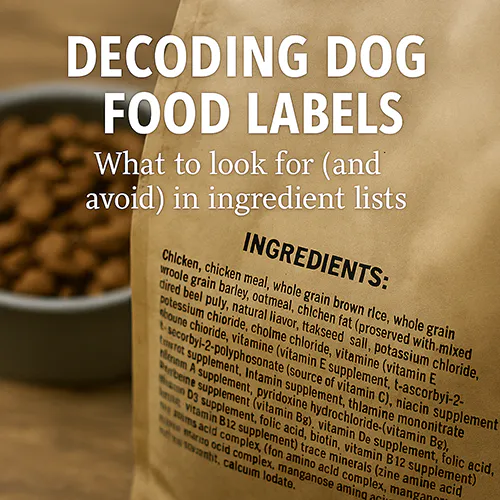
Do you REALLY know what you're feeding your dog? Most dog owners glance at the label, but knowing how to read it can mean the difference between a healthy diet and hidden problems... read on to find out the whole story.
Choosing the right food for a dog is one of the most important decisions an owner can make. The packaging may be colourful and the marketing persuasive, but the real story lies in the ingredient list. Understanding what is written there can help ensure a dog receives the nutrition it needs and avoids substances that may be of little value or even harmful.
The first thing to know is that ingredients are listed in order of weight before cooking. This means that the first few items make up the bulk of the food. A named meat, such as chicken or lamb, at the top of the list is usually a good sign, as it indicates a primary source of animal protein. However, fresh meat contains a lot of water, which is lost during processing, so it is worth looking at the next few ingredients to see if there are additional protein sources.
Meat meals, such as chicken meal or fish meal, are concentrated forms of protein that have had most of the water removed. These can be high-quality ingredients if they are clearly named. Vague terms like “meat meal” or “animal by-product meal” are less reassuring, as they do not specify the source and may include a mix of tissues of varying nutritional value.
Grains and carbohydrates are common in many dog foods. Whole grains like brown rice or oats can provide energy and fibre, but some foods rely heavily on cheaper fillers such as maize or wheat. While these are not inherently harmful to all dogs, they can be less digestible for some and may contribute little beyond calories. A long list of different carbohydrate sources can also be a sign of ingredient splitting, where similar items are listed separately to make them appear lower down the list.
Fats are essential for energy and coat health, but the source matters. Named animal fats, such as chicken fat, are preferable to generic “animal fat” which may be of uncertain origin. Some fats are preserved with natural antioxidants like mixed tocopherols, while others use synthetic preservatives such as BHA or BHT, which some owners prefer to avoid.
Additives and supplements are another area to examine. Vitamins and minerals are necessary for a balanced diet, but the form they take can vary. Chelated minerals, for example, are bound to amino acids and may be more easily absorbed. Artificial colours and flavours are not needed for a dog’s enjoyment and may be included purely for marketing appeal to humans.
Protein quality is not just about the amount but also the digestibility and amino acid profile. Animal proteins generally provide a better match to a dog’s needs than plant proteins, though some plant ingredients like peas or lentils can contribute useful nutrients. However, a heavy reliance on plant proteins can be a way to boost the protein percentage on the label without providing the same nutritional value as meat.
It is also worth noting that some ingredients serve multiple purposes. Beet pulp, for example, is a source of fibre that can aid digestion, but it is also a by-product of sugar production. Whether it is beneficial depends on the overall balance of the diet and the individual dog’s needs.
For dogs with allergies or sensitivities, reading the label carefully is essential. Common triggers include certain proteins, grains or additives. Limited ingredient diets aim to reduce the number of potential allergens, making it easier to identify and avoid problem foods. In these cases, clarity in labelling is especially important.
Wet and dry foods may list ingredients differently, but the principles remain the same. In wet foods, the higher water content means that fresh meat will naturally appear first, but the proportion of actual protein may be lower than it seems. Comparing the guaranteed analysis on a dry matter basis can give a clearer picture of nutrient levels.
Marketing terms like “premium”, “natural” or “holistic” are not regulated in the same way as nutritional claims. They may suggest quality, but they are not a substitute for reading the ingredient list. Similarly, images of fresh meat and vegetables on the packaging do not guarantee that these are present in significant amounts.
Understanding dog food labels takes practice, but it is a skill that pays off in better health and wellbeing for the animal. By focusing on clear, named ingredients, balanced nutrition and the avoidance of unnecessary additives, owners can make informed choices that suit their dog’s age, activity level and health status.
In the end, no single food is perfect for every dog. What matters is finding one that meets nutritional needs, is well tolerated and fits within the owner’s budget. Regularly reviewing the label is wise, as formulations can change without obvious notice. A food that was once ideal may alter its recipe, affecting quality.
Decoding a dog food label is not about chasing the most expensive brand or the latest trend. It is about understanding what is in the bag or tin and how it contributes to a dog’s diet. With this knowledge, owners can look past the marketing and focus on what truly matters: providing a diet that supports a long, healthy and active life.
